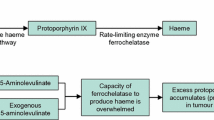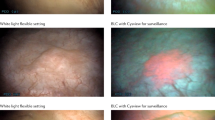Abstract
Purpose of Review
It has been firmly established that hexaminolevulinate-assisted blue light cystoscopy (HAL-BLC) reduces cancer recurrence rates. This review explores the impact of HAL-BLC on other meaningful outcomes in patients with bladder cancer, including disease progression, and earlier detection of disease at the time of surveillance cystoscopy.
Recent Findings
A randomized clinical trial confirmed earlier implementation of HAL-BLC at the time of surveillance cystoscopy increased identification of cancerous lesions, including those of high grade, when compared with white light cystoscopy. In addition, the evidence is evolving that the use of HAL-BLC at the time of endoscopic treatment of high-risk tumors may lead to lower rates of progression to muscle invasion, and this in part may be due to better risk stratification leading to changes in treatment plan.
Summary
The clinical contexts for the use of HAL-BLC are broader than prior knowledge. It is also becoming more clear that the positive impact of HAL-BLC is likely more than just reducing cancer recurrence rates, and patients would benefit from the technology at many time points in the management and follow-up of their disease.
Similar content being viewed by others
References
Papers of particular interest, published recently, have been highlighted as: • Of importance •• Of major importance
National Cancer Institute Surveillance. Epidemiology, and end results program. Cancer Stat Facts: Bladder Cancer. https://seer.cancer.gov/statfacts/html .
Canter DJ, Revenig LM, Smith ZL, Dobbs RW, Malkowicz SB, Issa MM, et al. Re-examination of the natural history of high grade T1 bladder cancer using a large contemporary cohort. Int Braz J Urol. 2014;40(2):172–8.
Cookson MS, Chang SS, Oefelein MG, Gallagher JR, Schwartz B, Heap K. National practice patterns for immediate postoperative instillation of chemotherapy in nonmuscle invasive bladder cancer. J Urol. 2012;187(5):1571–6.
Rieken M, Xylinas E, Kluth L, Crivelli JJ, Chrystal J, Faison T, et al. Long-term cancer-specific outcomes of TaG1 urothelial cancer of the bladder. Eur Urol. 2014;65(1):201–9.
Sylvester RJ, van der Meijden AP, Oosterlinck W, Witjes JA, Bouffioux C, Denis L, et al. Predicting recurrence and progression in individual patients with stage Ta T1 bladder cancer using EORTC risk tables: a combined analysis of 2596 patients from seven EORTC trials. Eur Urol. 2006;49(3):466–77.
Schmidbauer J, Witjes F, Schmeller N, Donat R, Susani M, Marberger M, et al. Improved detection of urothelial carcinoma in situ with hexaminolevulinate fluorescence cystoscopy. J Urol. 2004;171(1):135–8.
Jocham D, Witjes F, Wagner S, Jichlinski P, Guillou L, Karlsen SJ, et al. Improved detection and treatment of bladder cancer using hexaminolevulinate imaging: a prospective, phase III multicenter study. J Urol. 2005;174(1):862–6.
Grossman HB, Gomella L, Fradet Y, Morales A, Presti J, Ritenour C, et al. A phase III, multicenter comparison of hexaminolevulinate fluorescence cystoscopy and white light cystoscopy for the detection of superficial papillary lesions in patients with bladder cancer. J Urol. 2007;178(1):62–7.
Fradet Y, Grossman HB, Gomella L, Lerner S, Cookson M, Albala D, et al. A comparision of hexaminolevulinate fluorescence cystoscopy and white light cystoscopy for the detection of carcinoma in situ in patients with bladder cancer: a phase III, multicenter study. J Urol. 2007;178(1):68–73.
Marti A, Jichlinski P, Lange N, Ballini JP, Guillou L, Leisinger HJ, et al. Comparison of aminolevulinic acid and hexylester aminolevulinate induced protoporphyrin IX distribution in human bladder cancer. J Urol. 2003;170(2):428–32.
Krieg RC, Herr A, Raupach K, Ren Q, Schwanborn K, Knuechel R, et al. Analyzing effects of photodynamic therapy with 5-aminolevulinic acid (ALA) induced protoporphyrin IX (PPIX) in urothelial cells using reverse phase protein arrays. Photochem Photobiol Sci. 2007;6(12):1296–305.
Stenzl A, Burger M, Fradet Y, Mynderse LA, Soloway MD, Witjes JA, et al. Hexaminolevulinate guided fluorescence cystoscopy reduces recurrence in patients with nonmuscle invasive bladder cancer. J Urol. 2010;184(5):1907–13.
Hermann GG, Mogensen K, Carlsson S, Marcussen N, Dunn S. Fluorescence-guided transurethral resection of bladder tumors reduces bladder tumor recurrence due to less residual tumor tissue in Ta/T1 patients: a randomized two-centre study. BJU Int. 2011;108(2):E297–E3003.
Grossman HB, Stenzl A, Fradet Y, Mynderse LA, Kriegmair M, Witjes JA, et al. Long-term reduction in bladder cancer recurrence with hexaminolevulinate enabled fluorescence cystoscopy. J Urol. 2012;188(1):58–62.
Palou J, Hernandez C, Sosona E, Abascal R, Burgues JP, Rioja C, et al. Effectiveness of hexaminolevulinate fluorescence cystoscopy for the diagnosis of non-muscle invasive bladder cancer in daily clinical practice: a Spanish multicenter observational study. BJU Int. 2015;116(1):37–43.
Burger M, Grossman HB, Droller M, Schmidbauer J, Hermann G, Dragoescu O, et al. Photodynamic diagnosis of non-muscle invasive bladder cancer with hexaminolevulinate cystoscopy: a meta-analysis of detection and recurrence based on raw data. Eur Urol. 2013;64(5):846–54.
Chang SS et al. Diagnosis and treatment of non-muscle invasive bladder cancer: AUA/SUO guideline. AUA https://www.auanet.org/eduction/guidelines/non-muscle-invasive-bladder-cancer.cfm (2016).
Babjuk M, et al. EAU guidelines on non-muscle invasive urothelial carcinoma of the bladder: update 2016. Eur Urol. 2017;71(1):447–61.
Geavlete B, Multescu R, Georgescu D, Jecu M, Stanescu F, Geavlete P. Treatment changes and long-term recurrence rates after hexaminolevulinate (HAL) fluorescence cystoscopy: does it really make a difference in patients with non-muscle invasive bladder cancer? BJU Int. 2012;109(4):549–56.
Pellucchi F, Emilia R, Moschini M. Progression of T1 high-risk into muscle-invasive bladder cancer is an independent prognostic factor of mortality after radical cystectomy. World J Urol. 2014;191(4S):e685–6.
Schrier BP, Hollander MP, van Rhijn BW, Kiemeney LA, Witjes JA. Prognosis of muscle-invasive bladder cancer: difference between primary and progressive tumours and implications for therapy. Eur Urol. 2004;45(3):292–6.
Breau RH, Karnes RJ, Farmer SA, Thapa P, Cagiannos I, Morash C, et al. Progression to detrusor muscle invasion during urothelial carcinoma surveillance is associated with poor prognosis. BJU Int. 2014;113(6):900–6.
Sylvester RJ, van der Meijden AP, Lamm DL. Intravesical bacillus Calmette-Guerin reduces the risk of progression in patients with superficial bladder cancer: a meta-analysis of the published results of randomized clinical trials. J Urol. 2002;168(5):1964–70.
Oddens J, Brausi M, Sylvester R, Bono A, van de Beek C, van Andel G, et al. Final results of an EORTC-GU cancers group randomized study of maintenance bacillus Calmette-Guerin in intermediate and high risk Ta, T1 papillary carcinoma of the urinary bladder: one-third dose versus full dose and 1 year versus 3 years of maintenance. Eur Urol. 2013;63(3):462–72.
Lamm D, Persad R, Brausi M, Buckley R, Witjes JA, Palou J, et al. Defining progression in non-muscle invasive bladder cancer: it is time for a new standard definition. J Urol. 2014;191(1):20–7.
Kamat AM, Cookson M, Witjes JA, Stenzl A, Grossman HB. The impact of blue light cystoscopy with hexaminolevulinate on progression of bladder cancer-a new analysis. Bladder Cancer. 2016;2(2):273–8.
• Gakis G, Fahmy O. Systematic review and meta-analysis on the impact of hexaminolevulinate versus white-light guided transurethral bladder tumor resection on progression in non-muscle invasive bladder cancer. Bladder Cancer. 2016;2(3):293–300. A meta-analysis of four randomized and one retrospective study provides preliminary evidence that performing at least one TURBT with the addition of blue light cystoscopy reduces later risk of disease progression to muscle invasive disease.
• Daneshmand S, Bazargani ST, Bivalacqua TJ, Holzbeierlein JM, Willard B, Taylor JM, et al. Blue light cystoscopy for the diagnosis of bladder cancer: results from the US prospective multicenter registry. Urol Oncol 2018;36(8):361.e1–361.e6. A multicenter registry study of real-world data that confirms prior reports that use of blue light cystoscopy at the time of TURBT significantly increases detection of carcinoma in situ and papillary cancers when compared with white light alone. In a number of patients, the additional cancers identified only by blue light cystoscopy led to a change in clinical management including earlier recommendation for radical cystectomy.
Renninger M, Fahmy O, Schubert T, Schmid MA, Hassan F, Stenzl A, et al. The prognostic impact of hexaminolevulinate-based bladder tumor resection in patients with primary non-muscle invasive bladder cancer treated with radical cystectomy. World J Urol. 2019 Apr 27:1–10. https://doi.org/10.1007/s00345-019-02780-0[epub ahead of print].
Schneeweiss S, Kriegmair M, Stepp H. Is everything all right if nothing seems wrong? A simple method of assessing the diagnostic value of endoscopic procedures when a gold standard is absent. J Urol. 1999;161(4):1116–9.
•• Daneshmand S, Patel S, Lotan Y, Pohar K, Trabulsi E, Woods M et al. Efficacy and safety of blue light flexible cystoscopy with hexaminolevulinate in the surveillance of bladder cancer: a phase III, comparative, multicenter study. J Urol 2018; 199(5):1158–1165. A phase III randomized trial concluded that hexaminolevulinate-assisted blue light flexible surveillance cystoscopy identified more cancerous lesions than white light cystoscopy, including more high-grade bladder cancers. Many of the additional high-grade cancers identified only by blue light cystoscopy had normal urine cytology.
• Lane GI, Downs TM, Soubra A, Rao A, Hemsley L Laylan C et al. Tolerability of repeat use of blue light cystoscopy with hexaminolevulinate for patients with urothelial cell carcinoma. J Urol 2017;197(3):596–601. A retrospective study that provides results to support that repeat use of hexaminolevulinate-blue light cystoscopy is not associated with increased frequency or grade of adverse events when compared with one-time use.
Apfelbeck M, Grimm T, Kretschmer A, Buchner A, Bs S, Jokisch F, et al. Follow-up of high-risk bladder cancer-is it safe to perform fluorescence endoscopy multiple times in the same patient? Urol Oncol. 2017;35(10):602.e19–23.
Department of Health and Human Services. NDA 022555/S-005 supplement approval. FDA https:// www.accessdata.fda.gov/drugsatfda_docs/ appletter/2018/022555Orig1s005ltr.pdf (2018).
Baglo Y, Sousa MM, Slupphaug G, Hagen L, Havag S, Helander L, et al. Photodynamic therapy with hexyl aminolevulinate induces carbonylation, post-translational modifications and changed expression of proteins in cell survival and cell death pathways. Photochem Photobiol Sci. 2011;10(7):1137–45.
Bader MJ, Stepp H, Beyer W, Pongratz T, Sroka R, Kriegmair M, et al. Photodynamic therapy of bladder cancer: a phase I study using hexaminolevulinate (HAL). Urol Oncol. 2013;31(7):1178–83.
Author information
Authors and Affiliations
Corresponding author
Ethics declarations
Conflict of Interest
The authors declare that they have no conflicts of interest.
Human and Animal Rights and Informed Consent
This article does not contain any studies with human or animal subjects performed by any of the authors.
Additional information
Publisher’s Note
Springer Nature remains neutral with regard to jurisdictional claims in published maps and institutional affiliations.
This article is part of Topical Collection on Urothelial Cancer
Rights and permissions
About this article
Cite this article
Pohar, K.S. Blue Light Cystoscopy: Indications and Outcomes. Curr Urol Rep 21, 19 (2020). https://doi.org/10.1007/s11934-020-0966-5
Published:
DOI: https://doi.org/10.1007/s11934-020-0966-5




